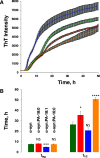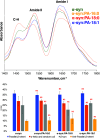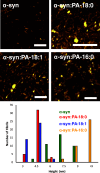Large Unilamellar Vesicles of Phosphatidic Acid Reduce the Toxicity of α-Synuclein Fibrils
- PMID: 38373398
- PMCID: PMC10915799
- DOI: 10.1021/acs.molpharmaceut.3c01012
Large Unilamellar Vesicles of Phosphatidic Acid Reduce the Toxicity of α-Synuclein Fibrils
Abstract
Parkinson's disease (PD) is a severe pathology that is caused by a progressive degeneration of dopaminergic neurons in substantia nigra pars compacta as well as other areas in the brain. These neurodegeneration processes are linked to the abrupt aggregation of α-synuclein (α-syn), a small protein that is abundant at presynaptic nerve termini, where it regulates cell vesicle trafficking. Due to the direct interactions of α-syn with cell membranes, a substantial amount of work was done over the past decade to understand the role of lipids in α-syn aggregation. However, the role of phosphatidic acid (PA), a negatively charged phospholipid with a small polar head, remains unclear. In this study, we examined the effect of PA large unilamellar vesicles (LUVs) on α-syn aggregation. We found that PA LUVs with 16:0, 18:0, and 18:1 FAs drastically reduced the toxicity of α-syn fibrils if were present in a 1:1 molar ratio with the protein. Our results also showed that the presence of these vehicles changed the rate of α-syn aggregation and altered the morphology and secondary structure of α-syn fibrils. These results indicate that PA LUVs can be used as a potential therapeutic strategy to reduce the toxicity of α-syn fibrils formed upon PD.
Keywords: AFM-IR; LDH; fibrils; phosphatidic acid; α-synuclein.
Conflict of interest statement
The authors declare no competing financial interest.
Figures





Similar articles
-
Cholesterol Accelerates Aggregation of α-Synuclein Simultaneously Increasing the Toxicity of Amyloid Fibrils.ACS Chem Neurosci. 2024 Nov 6;15(21):4075-4081. doi: 10.1021/acschemneuro.4c00501. Epub 2024 Oct 29. ACS Chem Neurosci. 2024. PMID: 39469734 Free PMC article.
-
Phospholipids and Cholesterol Determine Molecular Mechanisms of Cytotoxicity of α-Synuclein Oligomers and Fibrils.ACS Chem Neurosci. 2024 Jan 17;15(2):371-381. doi: 10.1021/acschemneuro.3c00671. Epub 2024 Jan 2. ACS Chem Neurosci. 2024. PMID: 38166409 Free PMC article.
-
The deglycase activity of DJ-1 mitigates α-synuclein glycation and aggregation in dopaminergic cells: Role of oxidative stress mediated downregulation of DJ-1 in Parkinson's disease.Free Radic Biol Med. 2019 May 1;135:28-37. doi: 10.1016/j.freeradbiomed.2019.02.014. Epub 2019 Feb 20. Free Radic Biol Med. 2019. PMID: 30796974
-
Protein-protein interactions regulating α-synuclein pathology.Trends Neurosci. 2024 Mar;47(3):209-226. doi: 10.1016/j.tins.2024.01.002. Epub 2024 Feb 13. Trends Neurosci. 2024. PMID: 38355325 Review.
-
Lipids: Key Players That Modulate α-Synuclein Toxicity and Neurodegeneration in Parkinson's Disease.Int J Mol Sci. 2020 May 7;21(9):3301. doi: 10.3390/ijms21093301. Int J Mol Sci. 2020. PMID: 32392751 Free PMC article. Review.
Cited by
-
Double-Negative CD4 CD8 Absolute Count Plays a Mediating Role in the Causal Relationship Between Plasma Lipids and Parkinson's Disease: A Mendel Randomized Study.Mol Neurobiol. 2025 May;62(5):6587-6597. doi: 10.1007/s12035-025-04691-1. Epub 2025 Jan 22. Mol Neurobiol. 2025. PMID: 39838179 Free PMC article.
References
-
- Marizzoni M.; Cattaneo A.; Mirabelli P.; Festari C.; Lopizzo N.; Nicolosi V.; Mombelli E.; Mazzelli M.; Luongo D.; Naviglio D.; et al. Short-Chain Fatty Acids and Lipopolysaccharide as Mediators Between Gut Dysbiosis and Amyloid Pathology in Alzheimer’s Disease. J. Alzheimer’s Dis. 2020, 78 (2), 683–697. 10.3233/JAD-200306. - DOI - PubMed
MeSH terms
Substances
Grants and funding
LinkOut - more resources
Full Text Sources
Medical
Research Materials
Miscellaneous

